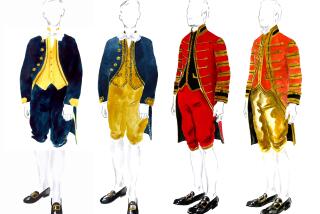Women in Black
- Share via
Like millions of others, Glenda Jackson was caught up in the television coverage of people grieving over Princess Diana’s death. But in Jackson’s case, mourning is a kind of hobby.
Jackson, who gives historic tours for the city of Ventura, is hooked on Victorian mourning traditions. She will lead a walking tour Saturday that delves into these grim, 19th-century customs and also highlights Victorian clothing, architecture and history.
Her “Victorian Secrets” tour runs from 1 to 3 p.m., beginning at Ventura City Hall and covering several downtown blocks. The cost is $6.
Jackson’s interest in things Victorian isn’t a passing fancy. She collects Victorian clothing, hats, furniture and other items, and she displays them in her Ventura home.
“My house is like a little museum,” she said. “The stuff is getting hard to find, and this is my way of saving history.”
For the tour, Jackson hauls out some treasures from her own collection, like an 1860s mourning dress with its hat and veil, and a vintage mourning bonnet edged with black lace and black beads.
It’s not that Jackson has a morbid streak. She is simply intrigued by England’s Queen Victoria and how she influenced not only mourning customs but other traditions and styles of the era.
“She and Prince Albert were madly in love,” Jackson said. When Albert died in 1861, the queen went into seclusion for years. “From 1861 to 1901 [the year of her death], she wore black.”
When she came out of seclusion, Victoria popularized mourning jewelry, Jackson said. She ordered jewelry--earrings, bracelets and lockets--made of jet, a type of black coal.
It was during her reign that mourning took on a certain protocol. For the first 30 days, widows stayed in seclusion and wore all black, including a black crepe mourning veil.
“Jackie Kennedy was the last public figure to wear the veil,” Jackson said.
Black-edged stationery was reserved for widows. With time, colors could be added: first white, then purple, then gray, then eventually all of them.
Jackson has an 1860s mourning bonnet in lavender, adorned with a jet black butterfly.
The proper mourning time for children was nine months. One of the more grim customs of the day was to take a memorial photograph of infants who had died.
“A hundred years ago, people in rural areas had traveling photographers, and the only photos taken were after death in a lot of cases,” said Jackson, who has one in her collection.
Morbid as it sounds, hair strands of deceased loved ones were woven into rings, pendants and other jewelry. Lockets carried locks of hair.
During her program, Jackson even tosses out some dark trivia. The term “living room” came into use to differentiate it from the parlor, where bodies of the deceased would lay.
Jackson leads her tour from City Hall to the nearby building that originally housed the Elizabeth Bard Memorial Hospital. Ironically, it was Cephas Bard, the city’s first doctor, who became the hospital’s first patient when it was built in 1902--and the first patient to die there.
From there, the tour stops at Joseph P. Reardon Funeral Chapel, where participants can view an 1890s, glass-enclosed, horse-drawn hearse. Then it’s on to the 700 block of Main Street, where they can see the original turn-of-the-century home of Capt. David Blackburn. Inside the Queen Anne-style house, now a law office, visitors can see the parquet floors and other elegant touches from the period.
BE THERE
“Victorian Secrets,” a walking tour focusing on Victorian mourning traditions, clothing, architecture and history. Saturday, 1-3 p.m., beginning at Ventura City Hall, 501 Poli St. $6. 658-4726.
More to Read
Sign up for The Wild
We’ll help you find the best places to hike, bike and run, as well as the perfect silent spots for meditation and yoga.
You may occasionally receive promotional content from the Los Angeles Times.






